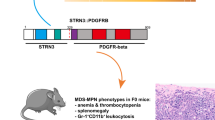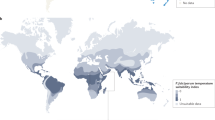Abstract
Most translocations that occur in Burkitt's lymphoma1,2 involve movement of part of chromosome 8, containing the c-myc gene, from its normal position to the immunoglobulin heavy-chain locus on chromosome 143–7. The genes are often joined at their 5′ ends in opposite transcriptional directions4–13. However, a significant minority of Burkitt translocations8 involve the light-chain loci on chromosome 2 (κ)14 or 22 (λ)15. We have characterized one of these from a European-derived cell line (IARC-BL37) that carries an 8;22 translocation. Here the translocation has joined the 5′ portion of the λ light-chain locus to the 3′ portion of the c-myc gene at a position about 7 kilobases from the normal c-myc promoters. The translocation is reciprocal and relatively conservative, involving the loss of only 21 base pairs from the site of recombination. This translocation allows us to orient the λ genes with respect to the centromere of chromosome 22 and to predict the orientation of other translocations involving these chromosomal segments. The 3′ translocation is accompanied by an increased level of c-myc transcripts, especially that derived from a normally under-used c-myc promoter.
This is a preview of subscription content, access via your institution
Access options
Subscribe to this journal
Receive 51 print issues and online access
$199.00 per year
only $3.90 per issue
Buy this article
- Purchase on Springer Link
- Instant access to full article PDF
Prices may be subject to local taxes which are calculated during checkout
Similar content being viewed by others
References
Manolov, G. & Manolova, Y. Nature 237, 32–33 (1972).
Zech, L., Haglund, U., Nilsson, K. & Klein, G. Int. J. Cancer 17, 47–56 (1976).
Kirsch, I. R. et al. Science 216, 173–175 (1981).
Taub, R. et al. Proc. natn. Acad. Sci. U.S.A. 79, 7837–7841 (1982).
Dalla-Favera, R., Martinotti, S., Gallo, R., Erikson, J. & Croce, C. Science 219, 963–967 (1983).
Hamlyn, P. H. & Rabbitts, T. Nature 304, 135–139 (1983).
Adams, J. M. Proc. natn. Acad. Sci. U.S.A. 80, 1982–1986 (1983).
Lenoir, G. et al. Nature 298, 474–476 (1982).
Battey, J. et al. Cell 34, 779–787 (1983).
Crews, R., Barth, R., Hood, L., Prehn, J. & Calame, K. Science 218, 1319–1321 (1982).
Shen-Ong, G. L., Keath, E. J., Piccolli, S. P. & Cole, M. D. Cell 31, 443–452 (1982).
Marcu, K. B. et al. Proc. natn. Acad. Sci. U.S.A. 80, 519–523 (1983).
Stanton, L. W., Watt, R. & Marcu, K. B. Nature 303, 401–406 (1983).
Malcolm, S. et al. Proc. natn. Acad. Sci. U.S.A. 79, 4957–4961 (1982).
McBride, O. W. et al. J. exp. Med. 155, 1480–1490 (1982).
Hieter, P. A., Hollis, G. F., Korsmeyer, S. J., Waldmann, T. A. & Leder, P. Nature 294, 536–540 (1981).
Hollis, G. F., Hieter, P. A., McBride, O. W., Swan, D. & Leder, P. Nature 296, 321–325 (1982).
Hieter, P., Korsmeyer, S. J., Waldmann, T. A. & Leder, P. Nature 290, 368–372 (1981).
Korsmeyer, S. J. et al. Proc. natn. Acad. Sci. U.S.A. 78, 7096–7100 (1981).
Blattner, F. et al. Science 196, 161–169 (1977).
Marcu, K. B., Lang, R. B., Stanton, L. W. & Harris, L. J. Nature 298, 87–89 (1982).
Neuberger, M. S. & Calabi, F. Nature 305, 240–243 (1983).
Berk, A. J. & Sharp, P. A. Cell 12, 721–732 (1977).
Taub, R. et al. Cell (in the press).
Dalla-Favera, R. et al. Proc. natn. Acad. Sci. U.S.A. 79, 7824–7827 (1982).
Southern, E. M. J. molec. Biol. 98, 503–517 (1975).
Chirgwin, J., Aeybyle, A., MacDonald, R. & Rutter, W. Biochemistry 18, 5294–5299 (1979).
Thomas, P. S. Proc. natn. Acad. Sci. U.S.A. 77, 5201–5205 (1977).
Suggs, S. V., Wallace, R. B., Hirose, T., Kawashima, E. H. & Itakura, K. Proc. natn. Acad. Sci. U.S.A. 78, 6613–6617 (1981).
Author information
Authors and Affiliations
Rights and permissions
About this article
Cite this article
Hollis, G., Mitchell, K., Battey, J. et al. A variant translocation places the λ immunoglobulin genes 3′ to the c-myc oncogene in Burkitt's lymphoma. Nature 307, 752–755 (1984). https://doi.org/10.1038/307752a0
Received:
Accepted:
Issue Date:
DOI: https://doi.org/10.1038/307752a0
This article is cited by
-
Mapping of MYC breakpoints in 8q24 rearrangements involving non-immunoglobulin partners in B-cell lymphomas
Leukemia (2007)
-
Mechanisms of transcription factor deregulation in lymphoid cell transformation
Oncogene (2007)
-
Mechanisms of chromosomal translocations in B cell lymphomas
Oncogene (2001)
-
Deregulation of the proto-oncogene c-myc through t(8;22) translocation in Burkitt's lymphoma
Oncogene (1999)
-
A novel gene, Translin, encodes a recombination hotspot binding protein associated with chromosomal translocations
Nature Genetics (1995)
Comments
By submitting a comment you agree to abide by our Terms and Community Guidelines. If you find something abusive or that does not comply with our terms or guidelines please flag it as inappropriate.



